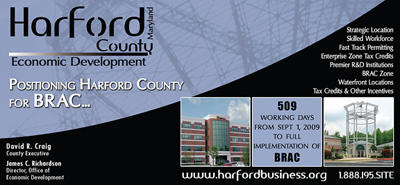s Commander in Chief, I will do whatever it takes to defend the American people, which is why we’ve increased funding for the best military in the history of the world. We’ll make new investments in 21st century capabilities to meet new strategic challenges, and we will always give our men and women in uniform the equipment and the support that they need to get the job done.”
These words were spoken by President Barack Obama on March 4th during a session focused on government contracts. They provide a clear indication of the importance and priority of the defense industry to our nation’s security, economy, innovation and job creation. Budget figures, trends and indicators, and actions on a state and local level, back that premise.
The U.S. Department of Defense’s base budget for 2009 rose to $515 billion, and for 2010, the President has requested $563 billion. In addition, the Heritage Foundation projects that funding for the core defense budget will increase by an average of about $10 billion per year between 2011 and 2014. To put that in some global perspective, the U.S. military budget back in 2005 accounted for almost as much as the rest of the world’s defense spending combined. The United States and its close allies are responsible for about two-thirds of the world’s military spending (of which, in turn, the U.S. is responsible for the majority). In 2007, U.S. military spending was above one-quarter of combined industrial and agricultural production in the country.
Specifically, military-related research and development spending – currently at about $80 billion (representing more than half of all federal R&D spending) – is an important component of defense spending overall, especially because of its positive economic impact across the country. Most defense research and development work is performed in the private sector by defense contractors, and substantial R&D work also is being performed by federally-funded research and development centers, defense laboratories, and colleges and universities. In fact, the Department of Defense is the third largest federal sponsor of academic research, behind the National Institutes of Health (NIH) and the National Science Foundation (NSF).
If you’ve been following the national discourse on defense over the past several months, you know there has been significant debate on topics such as spending emphasis overall; troop pull-out and re-assignment overseas; investing in technologies to combat new and emerging threats; increasing the size of the Army and Marine Corps; reducing cost overruns and delays; and more. Yet while there are differing opinions, important issues to address, and natural questions and concerns that come with change, one thing holds true – the defense industry is entering a new era of innovation that will result in both enhancing the security of the country and boosting our economy.
That innovation is gleaming in states and communities with inherent defense assets and ones likely to generate more defense contracts. Major defense contractors from the likes of Lockheed Martin down to small businesses (to which the DoD awards about $55 billion) have not been immune to the challenging economy, but seem to be holding steady. They, and the industries they represent – from software and communications to engineering and even video-gaming – are innovating, generating new applications and continuing to commercialize military technologies. They’re partnering with other organizations and universities to bring new defense technologies to life. And that ultimately creates the high wage jobs everyone wants.
In Florida, and specifically Orlando, that’s a cycle we continue to see happening. In 2006, Florida companies generated nearly $11 billion in Department of Defense Prime Contract awards, ranking?the state?4th in the nation. In fiscal year 2005, defense-related spending was responsible for $52 billion in output, or GSP, in Florida and accounted for 732,300 jobs. It’s projected that by 2010 the defense industry impact in the state will approach $59.5 billion.?Orlando, long known as the having the largest simulation and training cluster in the country, is home to more than 100 related companies employing nearly 17,000 people.
Those numbers drive home the fact that defense contractors cluster around military activity centers, especially around centers of acquisition and R&D activities. The strongest technology communities around the country tend to be those where the three components of defense, industry and academia are closely associated. A good example of this synergy and the resulting clustering effect can be seen in the Orlando simulation and training technology “center of excellence,” also referred to by the military as “Team Orlando.” The Team Orlando military commands are represented by all of the military services, working together to support the services’ simulation and training technology requirements; researchers at the University of Central Florida (now the fifth largest university in the country); and public and private entities.
A further look at Florida shows that the state is home to one of the nation’s largest defense and homeland security clusters, which encompasses everything from the manufacture of satellites, tanks, and biometrics to the development of vaccines. The convergence of related industries, such as information technology, photonics, modeling, simulation?&?training (MST), aerospace and life sciences, is fueling growth in defense. And Florida continues to be a hotbed for that convergence with Orlando serving as the hub for that activity.
These are all things that will be critical for future industry site selection decisions – from existing cluster locations, to the importance of partner universities for related research and development, to the fact that training and related technologies that support it remain top priority for the industry; to the convergence potential. And we cannot overlook the importance of two other important factors for the defense industry: a skilled work force that will continue to fuel the industry, as well as the spin-off, cross-over potential and further applications of the technology itself. The latter has proved to have significant impacts in Orlando as core defense simulation technology used to train our military is now driving advancements in medical simulation, for example, with immense growth potential.
As President Obama said on March 4th, increased investments in our military will result in new technologies and capabilities that will enhance our national security and will drive innovation and economic opportunities – from weaponry, infrastructure and training, to intelligence gathering and surveillance, to many new applications that cross multiple industries. It’s a time of transition and change ? one that the industry will seize upon to advance our position as the mightiest force and technological leader in the world.
Russ Hauck is the executive director of the National Center for Simulation (NCS) in Orlando, Fla., which serves as the link among the defense industry, government and academia on behalf of the entire simulation, training and modeling community. The NCS mission is to serve as an information resource and to facilitate networking among its growing local, national and international membership and potential partners and customers in government, industry, education, and commerce.


